This is a guest post by Chelsea Rochman. Chelsea is a post-doc at the University of California Davis. This is her second guest post at DSN.
 The long and windy path to a Ph.D. is lined with blood, sweat and tears. Like a roller coaster, it can be filled with joy, anxiety, fear and even nausea. This story is regarding one chapter of my dissertation, one that filled me with all these emotions and lead me to the conclusion that even in science, sh%* happens. But in this story, what we could not control lead us to better scientific conclusions with greater environmental realism. Due to what may seem like an experimental shortcoming, we were able to answer an important “so what?” question related to plastic marine debris.
The long and windy path to a Ph.D. is lined with blood, sweat and tears. Like a roller coaster, it can be filled with joy, anxiety, fear and even nausea. This story is regarding one chapter of my dissertation, one that filled me with all these emotions and lead me to the conclusion that even in science, sh%* happens. But in this story, what we could not control lead us to better scientific conclusions with greater environmental realism. Due to what may seem like an experimental shortcoming, we were able to answer an important “so what?” question related to plastic marine debris.
Today, it’s nearly impossible to avoid the many images of marine mammals, birds and turtles entangled in plastic debris or washed up with large plastic items in their digestive tract. What we don’t see, but may question, is how the chemical pollutants associated with plastic debris interact with marine life and potentially our seafood.
When plastic becomes marine debris it accumulates several chemical pollutants swirling in seawater such as pesticides (e.g. DDT), industrial chemicals (e.g. PCBs) and metals (e.g. lead) adding to the several potentially hazardous ingredients (e.g. PBDEs and bisphenol A) already in the plastic material. Thus plastic debris presents a “cocktail” of chemical contaminants to marine animals when mistaken as a meal.
As such, it has been hypothesized that plastic debris acts as a transporter of these chemicals, several of which can be toxic at certain doses, to animals upon ingestion. While we have strong evidence that hundreds of species eat plastic debris, and several case studies showing that plastic ingestion can physically harm an animal, we have little evidence of the fate of chemicals associated with plastic debris when ingested by marine life.
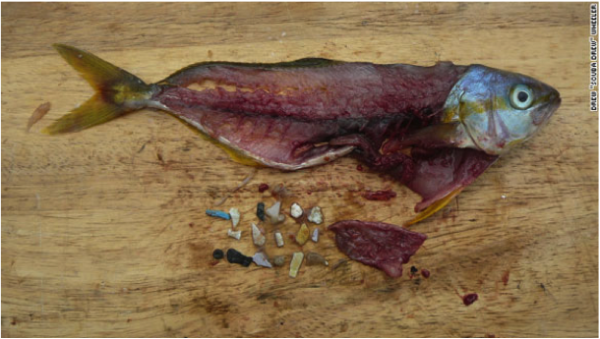
In our laboratory, the Aquatic Health Program at UC Davis, we designed an experiment to determine if plastic ingestion is indeed a mechanism for persistent organic pollutants (POPs) to accumulate in marine life. Because we wanted to understand how marine plastic debris might interact with both ecology and human health, we chose to conduct our study using fish, suggested as a good indicator of ecosystem health and a common seafood item.
To do this, we devised a rigorous controlled experiment, using clean laboratory-reared Japanese medaka and a contaminant-free diet made in the laboratory. This way we could be sure any contamination in our fish was a product of plastic ingestion. We also bound the plastic to the diet in our two plastic treatments so we could be sure these fish were eating the plastic. OR SO WE THOUGHT…
Similar to nature, and even with our best efforts, sometimes controlled laboratory experiments are not as controlled as planned… Instead, all 3 diets (negative control, virgin polyethylene and polyethylene marine debris) turned out to be contaminated with POPs (as cod liver oil is an ingredient in our formulated diet). Moreover, the plastic particles completely dispersed from the diet when sprinkled into the fish tanks at each feeding.
Immediately, we began to panic. We feared our fish would not eat the plastic at all and if they did that it would be impossible to decipher contamination from plastic versus contamination from their diet. After several days of freaking out, worrying all our work had gone to waste, what seemed to be a catastrophe became a blessing in disguise. HALLELUJAH!!
DUMB LUCK #1: The oceans are a toilet bowl for chemical contaminants, including POPs. As such, these chemicals are ubiquitous in marine foodwebs in the absence of plastic debris. While it is well-known that these chemicals contaminate plastic debris, and there is some evidence that these chemicals transfer to animals (e.g. lugworms) upon ingestion, it is not clear if the source of POPs from plastic to marine animals matters in an already contaminated system. What I mean is: in the presence of plastic debris, is an organism at risk of accumulating a higher dose of POPs? As a consequence of the contamination in the cod liver oil, we were able to examine this question because our experiment included contamination in the foodchain (i.e. the diet) of all treatments with the addition of more POPs on the polytethylene in the marine-plastic treatment.
DUMB LUCK #2: The plastic did not bind to the diet and instead, upon feeding the fish, the plastic dispersed and floated independently in the water as it does in the real world. Fish were not force-fed plastic, but instead were exposed to it and had to “choose” to eat it. In this way, we were able to consider the dose of plastic to the fish in amount of plastic per volume of water. As such, the exposure concentration of plastic floating in our tanks was less than some of the largest concentrations found in the “garbage patches” of the subtropical gyres, and thus environmentally relevant. And to our surprise, the fish ate plastic and continued to do so for the entire 2 months!!
Thus, with a lot of hard work and good attitudes regarding laboratory mishaps, our experiment became ecologically relevant. Initially, we were only able to ask the mechanistic question: “do contaminants on plastic transfer to fish upon ingestion?”. Instead, we could address the more relevant question, “is plastic, at real-world concentrations, an important vector of contaminants to the foodweb, despite widespread and global contamination of these chemicals in seawater, sediment and the marine food chain?”.
After a 2-month exposure to plastic, the concentrations of POPs in the fish demonstrated that despite contamination in the diet, concentrations of POPs were greater in fish fed plastic with sorbed chemical pollutants. For some chemicals, this significantly greater concentration in fish suggests that plastic debris can be an important vector of POPs into marine life and thus potentially into the seafood we put on our own plates.

For more information, check out the published study, and feel free to ask questions in the comment section.
Share the post "Guest post: The invisible consequences of mistaking plastic for dinner"

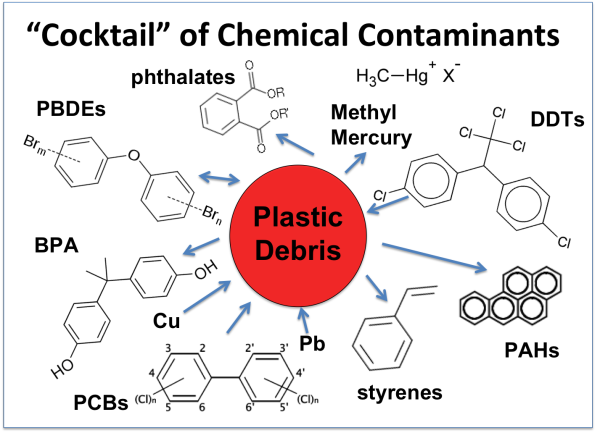
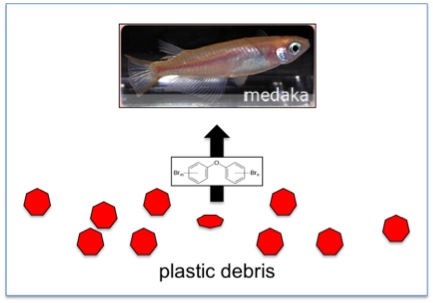
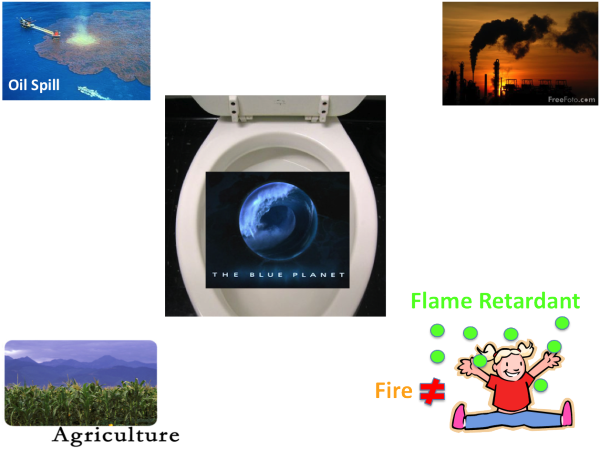


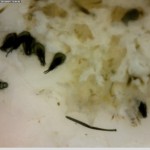
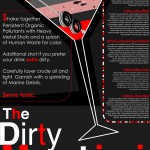
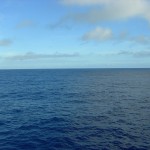
Hi,
Refering to the middle diagram, on the total concentration of PCB in the fish; how is it possible that the controlled fish has much higher concentration of PCB in its tissue than the fish that ingested virgin plastic?
Hi Malcolm. Great question! This was an interesting result. Remember all three diets had PCBs because it was in the fish oil that was mixed into their food. Fish that were eating a mixture of virgin plastic and diet either A) received less PCBs via their diet because they were eating plastics or B) the plastic actually absorbed some of those PCBs in their gut allowing less to transfer to the tissue of the fish. I am guessing the answer is A, but there is a paper published by Todd Gouin in 2012 in ES&T that suggests it may have been B. We don’t see this for PBDEs and PAHs possibly because the virgin plastics had these chemicals as additives or byproducts of manufacturing. I hope that makes some sense :)